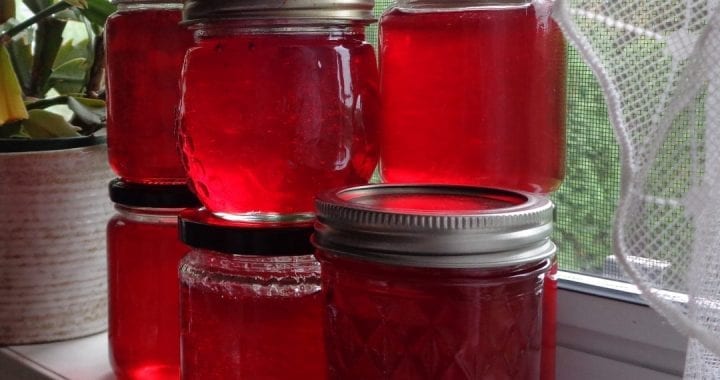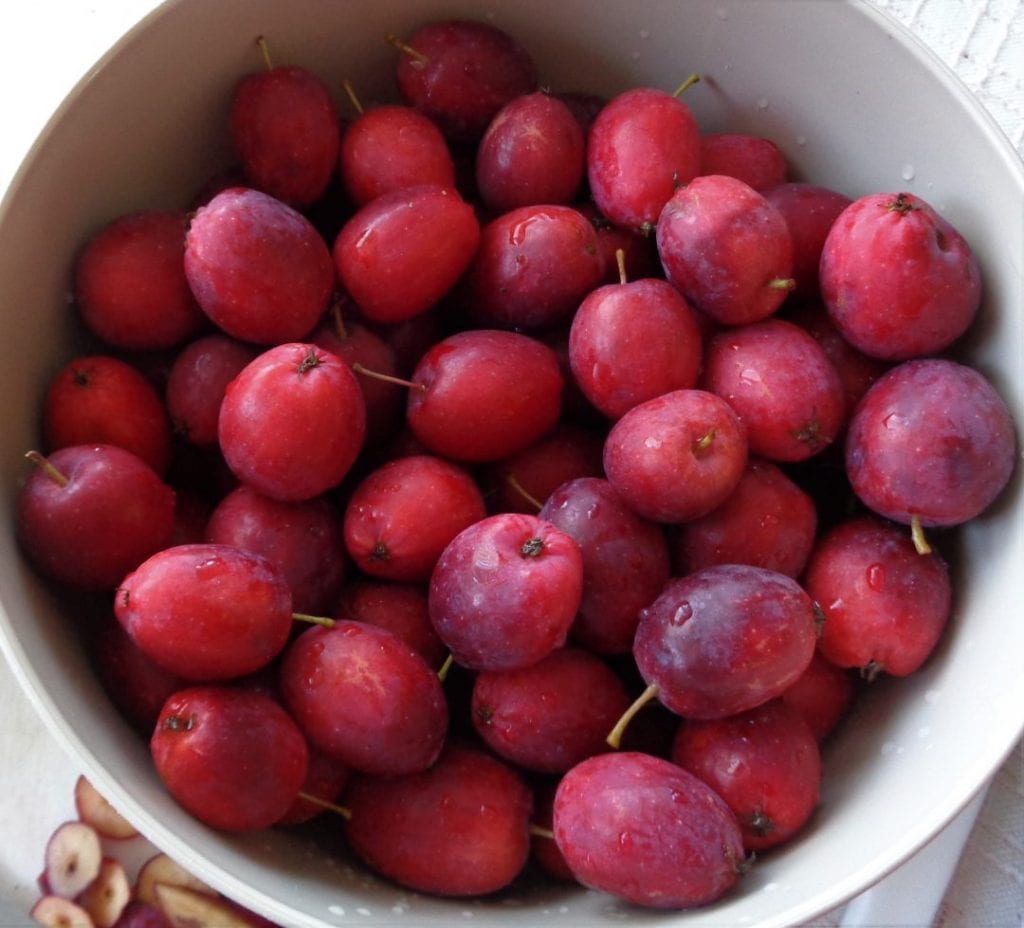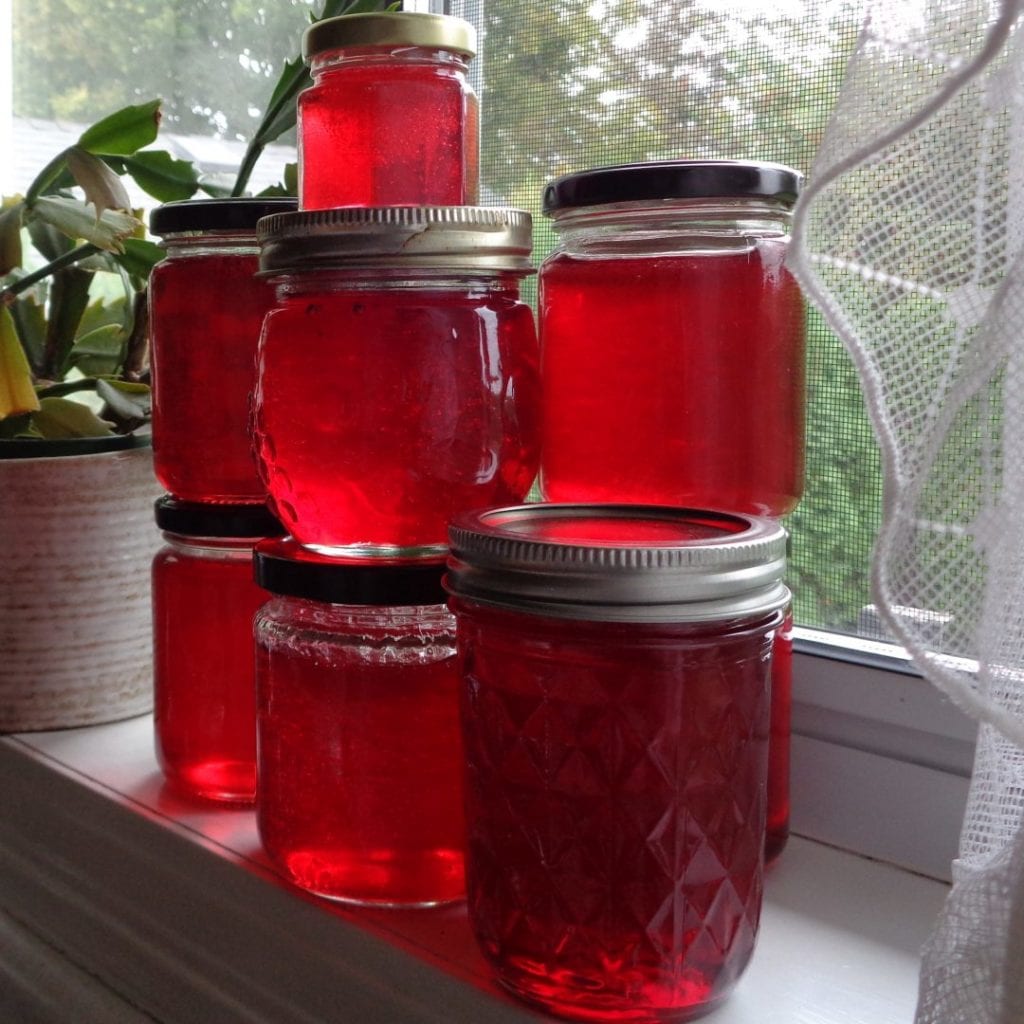Crabapples are grown in orchards to help with pollination. They so do not make good eating apples but my do they make nice jelly. Crabapples are naturally full of pectin so no Certo required. Jean has a tree in her orchard and the crabapples are ripe with a glorious shade of red. Yesterday I was gifted with just over three pounds of lovely jewel toned little football shaped apples.
As I have begun preserving for Yule gifts, this seemed like a delicious way to begin a basket of homemade walnut scones, clotted cream and crabapple jelly; maybe I could throw in a special box of tea or a bag of coffee and a short game. As we age, more of my friends are appreciating gifts that go away and don’t require dusting. A basket of treats can bring a family or group of friends together in the middle of all the hecticness for an hour of togetherness.
Crabapples hold a connection to love and marriage. Legends say if you throw crabapple pips into a fire while repeating your love’s name, the pips explode if the love is true. The Celts burned applewood during fertility rites and festivals, and even Shakespeare references crab apples in Love’s Labour Lost and A Midsummer Night’s Dream.
You will need:
3 pounds of beautiful red crabapples
2 sticks of cinnamon
20 cardamon pods
5 star anise
2 inches fresh ginger
1 cup sugar for each cup of juice
Harvest time is the easiest time for finding gratitude in the bounty of the earth. All the wonderful delights that grow and are available to nourish us. Hold those thoughts of gratitude in your heart as you find your apron. Wash hands, deep relaxing breaths and an invitation to the compassionate spirits to join in the adventure. Begin.
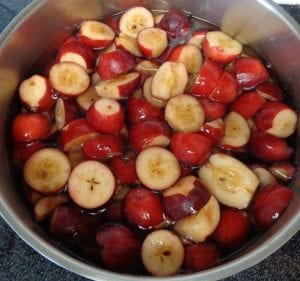 Wash the crabapples, take off the stem and cut the blossom end of the fruit off.
Wash the crabapples, take off the stem and cut the blossom end of the fruit off.
Cut in half and remove any blemishes.
The less ripe the crabapple the higher the pection amount. This was a full recipe of ripe crabapples but if you can manage a 1/4 under ripe, 3/4 ripe mixture there will be slightly firmer set to the finished jelly.
Under ripe crabapples have more of a beige coloured seed inside while ripe crabapples tend to be a darker brown.
Add about 3 1/2 cups of water. The apples do not need to be fully covered and they will reduce down as they cook.
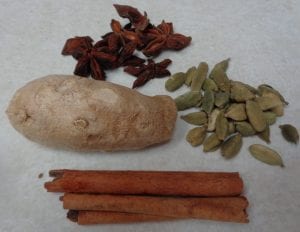 Prepare the ginger by peeling and cutting in quarters.
Prepare the ginger by peeling and cutting in quarters.
I didn’t worry about gathering the spices together in cheesecloth as the entire mixture will drain the juices away and the leftover crabapple mass and spices will go into compost.
This is a great time to use up any broken star anise as you are really after the flavour and then whole pretty ones can be used for other projects.
The list and quantity of spices I used is above but they are by no means the only possible combination.
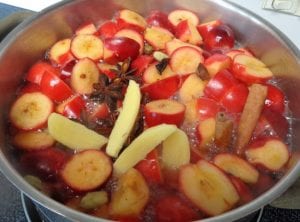 Place the pot over a medium heat, add the spices and bring the entire mixture to a slow boil.
Place the pot over a medium heat, add the spices and bring the entire mixture to a slow boil.
Reduce to a simmer and and cook for fifteen to twenty minutes until the crabapples are disssolving.
Do not over cook as that will destroy the pectin in the apples but you want the apples themselves to be falling apart so as to allow all their juices to drain out in the next step.
Place a collander in a bowl and lay a cloth inside the collander. 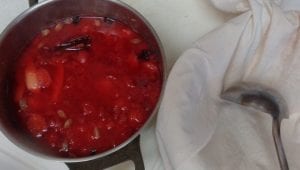
Transfer the cooked apples into the collander to begin draining.
The first few cups will move quickly through the collander so ensure the bowl underneath large enough to hold the juice.
As long as there is enough space between the bottom of the colander and the bottom of the bowl juices can drip and not just sit in liquid, it is possible to just let the mixture drip this way.
A second option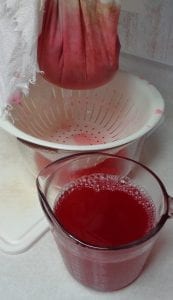 is to tie the cloth together and then secure it in a position that will allow it to continue dripping.
is to tie the cloth together and then secure it in a position that will allow it to continue dripping.
As a general rule of thumb, pressing the liquid will make the final juice and therefore the jelly cloudy as smaller bits of foodstuff get through the cheescloth. The trick is not to use cheesecloth with its larger space weaving but untreated muslin with a much tighter weave.
Let the crabapples drip for at least several hours or possibly even overnight.
I had separated the first drip into the 4 cup measure. I then squeezed to see what I would get from the last of the juices. There will be more flavour in this last section but if one were going to enter jelly in a contest, clarity would be one of the critieria. I was not going to automatically add this last cup without checking out what I had.
Squeezing gave me and additional 1 1/4 cups juice. In this case after sitting a while, both containers looked identical so I decided to add them together to finish off the jelly.
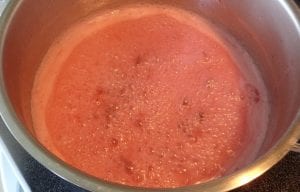 This is a good place to stop if the day is getting away from you. It is possible to cover the juice and refrigerate until there is time in the next day or so to finish off the jelly.
This is a good place to stop if the day is getting away from you. It is possible to cover the juice and refrigerate until there is time in the next day or so to finish off the jelly.
When the next step begins, be sure to use a large pot that has plenty of space for the jelly to bubble up.
You can see in the next picture how much further up the pot the bubbles go once the boiling starts.
Place two or three saucers in the freezer for testing your jelly. They will need at least five minutes to cool before using.
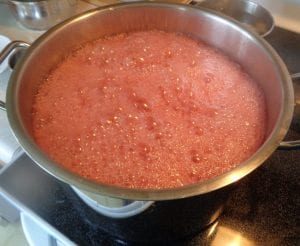 Measure the liquid collected and add an equal amount of sugar to the pot. Stir to begin the dissolving and then bring to a boil over medium heat.
Measure the liquid collected and add an equal amount of sugar to the pot. Stir to begin the dissolving and then bring to a boil over medium heat.
Cook until a candy thermometer shows 220 degrees F . To be extra sure you won’t have syrup when the mixture cools, place one teaspoon of jelly onto one of the saucers in the freezer. Return the saucer to the freezer for 1 – 2 minutes and then test by pushing a finger into the jelly. It should wrinkle as you move forward. Here is a video to help if this is new to you.
I suggest you add the backup second test as thermometers are not always accurate and elevation will change the temperature required. If the jelly does not pass the test, return to the heat and cook for another 3-4 minutes before testing again.
Transfer the jelly to hot sterilzed jars. Seal, process an label as you would normally.
Aren’t these the perfect colour for a Yule gift?
Spiced Crabapple Jelly from My Kitchen Wand

